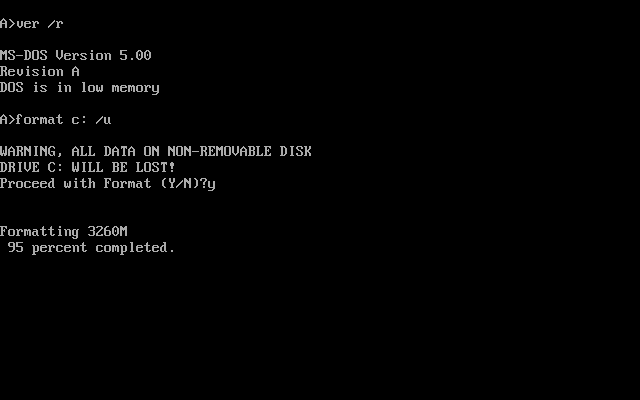First post, by voodoo5_6k
- Rank
- Member
Hi all,
I need some out-of-the-box thinking and fresh perspective as I’m currently hitting a brick wall due to very scarce free time (and I must admit I haven’t been using DOS and the corresponding systems for 20 years). Maybe another VS440FX user or someone knowledgeable can point out something obvious I’m currently overlooking...
Background:
A few month ago I thought about setting up another retro PC which should be used for real DOS in addition to running everything in DOSBox. My Roland CM-32L and SC-55 would be shared with this machine too (using a Roland Edirol UM-550). For that purpose I recently purchased one of Keropi's brilliant Music Quest PC-MIDI IH9MQ9 clone cards. Then, I assembled the system using some of my old parts and a few newly purchased parts and wanted to get rolling with the DOS 6.22 installation.
System specifications:
CPU: Intel Pentium Pro 200MHz 1M
Cooler: Thermaltake Venus 12 + Noctua NF-A8 FLX (modified to fit & mounted with Socket 8 clamp)
Mainboard: Intel VS440FX (BIOS 1.00.18.CS1)
RAM: Kingston 64MB EDO 60ns (2x 32MB)
PSU: Enermax EG301AX-VE(G) 303W
Add-in cards:
PCI1: Diamond Monster 3D
PCI4: Eontronics S3 Virge/DX
ISA2: Music Quest PC-MIDI IH9MQ9 (Keropi’s clone card)
ISA4: Creative Labs Sound Blaster AWE64 Gold
Drives:
FDD: Alps Floppy Drive
SSD: Corsair CSSD-F60GBLSB 60GB *
ODD: Sony DDU1681S-01 *
* connected to IDE via Manhattan 158282 SATA300 Drive to IDE Host Controller Converter
Problem description:
The system initializes fine, the CPU is detected with the full 1M cache, the BIOS is entirely on default settings (Clear CMOS jumper set). All drives are detected. Using a boot-floppy, all drives can be accessed (incl. read/write on the SSD). MS-DOS 6.22 installs fine on the SSD. Rebooting the system with the boot-floppy removed leads to an error message, no system disk or disk error, etc. (boot order is first Floppy, then Harddisk). Removing this SSD (keeping the installed MS-DOS 6.22) and connecting it to some other retro systems/spare parts I have leads to no errors at all. It boots DOS on my Asus P2B-DS with dual PII 450MHz CPU, and it boots DOS on my Intel Advanced/ML with a P200 (in this case even using the same PSU).
Steps already performed:
- Wiped the SSD and created FAT16 partitions for DOS with PartitionMagic 7.0 (with its emergency floppy set), with Windows 7, with FDISK, in various sizes --> No change
- Repeated the installation --> No change
- Tested the SSD/the DOS installation in other systems --> Working flawlessly
- Used an HDD instead of the SSD --> No change
- Recovered the VS440FX BIOS (via recovery jumper and BIOS floppy) --> No change
- Removed all cards (except VGA) and all unnecessary drives --> No change
- Changed the IDE settings to user definable and entered the same configuration the Advanced/ML uses --> No change
- Deactivated all integrated periphals I don’t use --> No change
- Connected the drives to an PCI SATA controller and deactivated the onboard controller --> No change (all drives detected, same error message)
I currently don’t have a working IDE harddisk available to check whether that makes any difference, but the fact that the SSD/converter combo works fine on the Advanced/ML (roughly same age, same manufacturer, comparable BIOS with even more restrictions), that it got detected by the VS440FX, and that DOS installs fine made me doubt that will really change anything.
Of course I could just switch to the Advanced/ML and use that as a DOS PC. But that is definitely my last option, when everything else has failed and all is lost... I’d really like to get this Pentium Pro PC up and running.
Thanks in advance for all your thoughts, ideas and help!
END OF LINE.

